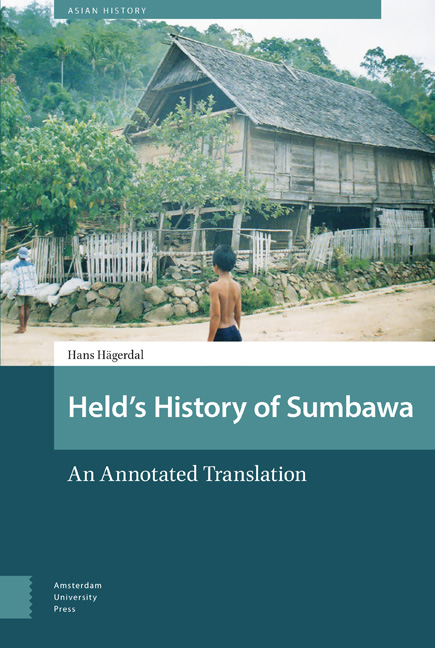Book contents
- Frontmatter
- Contents
- List of Figures and Tables
- Map
- Translator’s Introduction
- 1 The Ancient Period
- 2 Islam and Makassar
- 3 The Sumbawan Kingdoms under VOC Suzerainty (1)
- 4 The Sumbawan Kingdoms under VOC Suzerainty (2)
- 5 In the Wake of the Tambora Disaster
- 6 From Colonial rule to Independence
- Appendix: Lists of Sumbawan Rulers
- Bibliograph
- Index
Translator’s Introduction
Published online by Cambridge University Press: 10 December 2020
- Frontmatter
- Contents
- List of Figures and Tables
- Map
- Translator’s Introduction
- 1 The Ancient Period
- 2 Islam and Makassar
- 3 The Sumbawan Kingdoms under VOC Suzerainty (1)
- 4 The Sumbawan Kingdoms under VOC Suzerainty (2)
- 5 In the Wake of the Tambora Disaster
- 6 From Colonial rule to Independence
- Appendix: Lists of Sumbawan Rulers
- Bibliograph
- Index
Summary
Yearning and wondering, Kajsa and I had been looking at the sky-high Tambora volcano from our camp on Satunda. In the middle of the day it lay embedded in dense, white clouds and hidden for our gazes. Early in the morning however, and right before the sunset, the sight was clear and our eyes were drawn towards the jungle-clad mountainside, up to the barren top which made an uneven silhouette, sometimes in the bluest blue, sometimes in violet, purple or gold.
– We will encamp high up there in a few weeks, I said to our boy Duruhama. From there Satunda will look like a small bubble on the sea! Duruhama shook his head, disapprovingly.
– This is no good place, tuan. It is terribly cold on Tambora. And there are large, dangerous dogs – so large that their footprints are as those of tigers. When they bark, something in your ears is damaged, so you become completely deaf. And even worse are the forest people. They live in the trees and are no larger than children, and are mean and horribly ugly. Nay, tuan, it is better to stay here on Satunda!
Had it only been true! How about catching a little forest troll, hairy and with a tail, or a cute puppy, large as a horse! However, vain hope; it is only the folk fantasy which – apart from the same pucks, goblins trolls and fairytale animals as back home – have also created a bunch of others on the Lesser Sunda Islands. Every mountain, every river and lake are populated by curious beings, and when you try to gather data about the animals of the islands, the islanders usually blend fancy with reality and tell about the most hideous fauna.
Thus did the Swedish adventurer and cameraman Rolf Blomberg describe his experience with Sumbawa in the last waning days of the Dutch East Indies in 1941. Attracted by the dragons of nearby Komodo, Blomberg was one of the utter few outsiders to describe this sizable island, half the size of Belgium, for the general audience. His perspective might be typical of an educated Western traveller in late colonial Asia: a keen sense of observation coupled with a somewhat patronizing attitude to his ‘boy’ and the superstitions that permeated local culture.
- Type
- Chapter
- Information
- Held's History of SumbawaAn Annotated Translation, pp. 9 - 28Publisher: Amsterdam University PressPrint publication year: 2017



